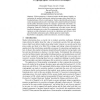Free Online Productivity Tools
i2Speak
i2Symbol
i2OCR
iTex2Img
iWeb2Print
iWeb2Shot
i2Type
iPdf2Split
iPdf2Merge
i2Bopomofo
i2Arabic
i2Style
i2Image
i2PDF
iLatex2Rtf
Sci2ools
FC
2007
Springer
2007
Springer
Cryptographic Securities Exchanges
While transparency in financial markets should enhance liquidity, its exploitation by unethical and parasitic traders discourages others from fully embracing disclosure of their own information. Traders exploit both the private information in upstairs markets used to trade large orders outside traditional exchanges and the public information present in exchanges’ quoted limit order books. Using homomorphic cryptographic protocols, market designers can create “partially transparent” markets in which every matched trade is provably correct and only beneficial information is revealed. In a cryptographic securities exchange, market operators can hide information to prevent its exploitation, and still prove facts about the hidden information such as bid/ask spread or market depth.
Related Content
| Added | 07 Jun 2010 |
| Updated | 07 Jun 2010 |
| Type | Conference |
| Year | 2007 |
| Where | FC |
| Authors | Christopher Thorpe, David C. Parkes |
Comments (0)

